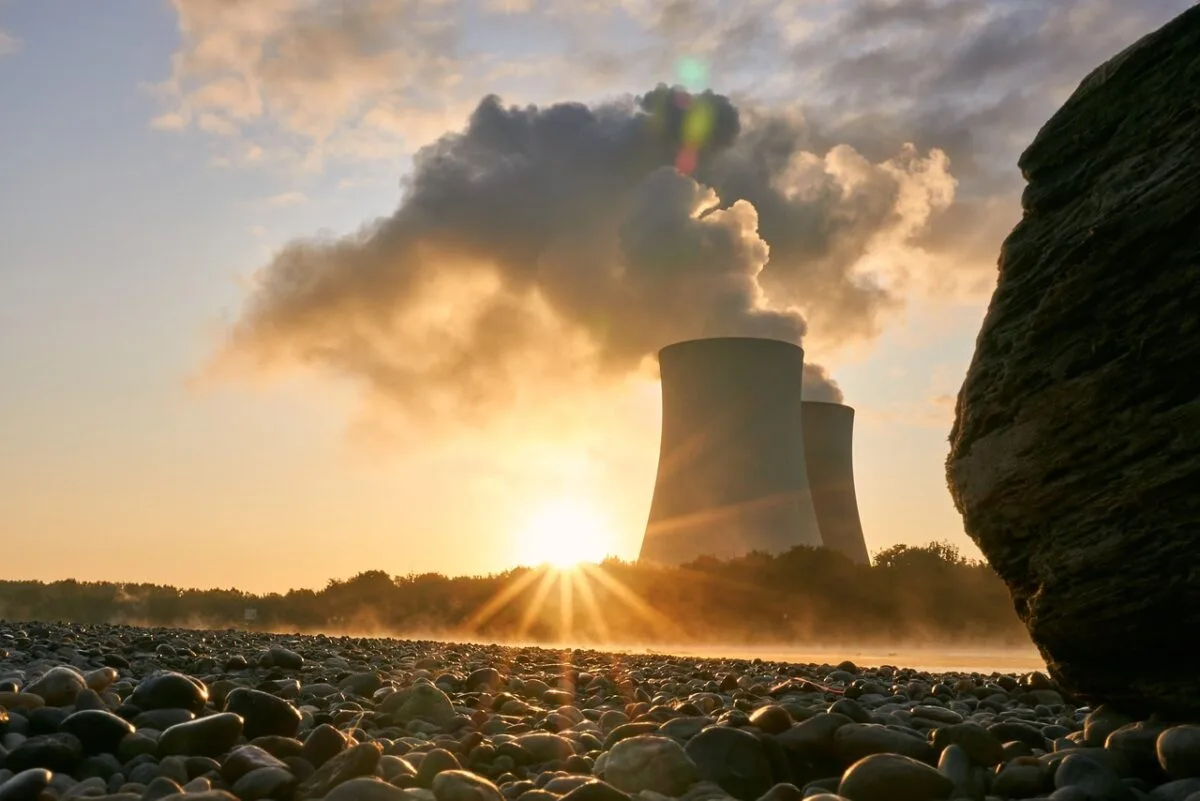Yes, because profit is what’s so important and not part of creating the problem, right?
Why not use both?
Because we only have limited resources and they have to be used wisely. So if it is cheaper to build solar, rather then nuclear, we should use our workers to build solar. The other problem is that nuclear reactors do not last forever, so over time, they will be phased out, just due to economics.
The problem is it’s not that simple from a climate perspective. Solar and wind are great but are incredibly variable which is not good when you need a guaranteed baseline electricity production. There is no situation under which a large nation could reliably just use wind/solar to power the country. Currently nuclear is the only renewable, clean energy source that can produce a stable output.
Nuclear is not renewable. It uses uranium as fuel. It is low carbon and emission free, but not renewable.
There are two solutions to intermittency. First one is a large grid with a lot of differen renewable power sources. It is always sunny somewhere, so when you can move the electrcitiy around, you have much less of a problem. Even better ifyou have wind power as well. With a continent sized grid, you basicly avoid the problem of cloudy days.
Next part is storage. Due to the large grid size you have the ability to use hydro power plants with reservoir as long term storage for particullarily cloudy days or winter and battery and pumped hydro for nights. Biomass is also an option if need be. Maybe we later hydrogen as long term storage as well, for really bad weeks and using it mainly for say chemical plants. Again the better large and interconnected the grid the less storage is needed. In some regions namely large sunny deserts having a nights worth of storage and some emergency backup biomass power plants would be enough. Basicly it runs down to less then a day worth of storage
There are also actually renewable baseloads like hydro power for flow power plants and geothermal, which are also good options. Also variable demand is a thing, which allows for even more renewables.
Seriously intermittency is much less of a problem, then it is made out to be. You just have to add a bit of interconnection and storage to it, but even that is not that expensive and seriousyl usefull.
This is the lie that is told, but nuclear has trouble getting grid penetration over 70% even with massive overprovision and storage via foreign interconnect.
Stable output which is totally interrupted for weeks at a time isn’t useful for meeting a combination of stable, variable, and dispatchable loads. Nor does it contribute meaningfully alongside variable output.
You and many people overestimate the effect of clouds on solar power generation. Even on cloudy days solar panels still produce mostly the same amount of power. On the absolutely darkest cloud days, solar panels still put out about 50% the same amount of energy they generate on perfectly clear sunny days. And that’s only for the absolutely darkest cloud days, whereas if it’s just a typical overcast kind of day the output will be a lot higher. So even if society went to being completely solar powered, you’d only need 50% more solar power generation to be completely meeting your needs even on the cloudiest days.
Isn’t the issue more going to be the solar power generation during winter - which happens to also be when energy demand is greatest?
It probably depends on where you live, but from a quick web search i see sources saying most energy is used in the summer. ( https://learn.pjm.com/three-priorities/keeping-the-lights-on/how-energy-use-varies.aspx ). In locations that receive less sunlight you would simply need more solar panels to meet your needs. In those rare areas that truly receive very little sunlight for months you would choose other technologies like wind, especially since those dark areas likely correlate with where wind is stronger and steadier.
But my comment was in reply to the person who claimed that solar wont work when it’s cloudy, which is false. Solar works great even when it’s cloudy.
Oh you originally responded to me but I never said anything about cloud cover.
And Europe energy crisis last winter was partly due to unperfect meteorological conditions over Europe.
And solar panels produce zero energy during the night.
No reason to fight the tide. Renewables and storage are enough.
People just say “storage” as if it’s some simple solution. It’s not. Pumped hydro can work in some places but it can also cause pretty impactful disturbances for the local ecosystem so it needs to be planned with care. Hydrogen storage is not a mature technology yet, it’s still in the trial stage and has pretty poor performance (something like 35% round-trip efficiency), not to mention the issues with hydrogen gas leaking due to its small molecular size. Shouldn’t even start discussing lithium ion, but the danger of thermal runaway should alone be enough of a reason to plan it very carefully.
Don’t get me wrong, renewables + storage is the future, aside from eventual fusion power it’s the cheapest and most environmentally friendly alternative. But a lot of people talk as if there aren’t enormous technical challenges in stabilizing a power grid with renewables at the moment. Remember that precisely all of the power that is put into the grid has to be pulled out of the grid, every minute of every hour of every day of the year, as soon as that equilibrium is broken in either direction we experience significant issues.
There’s so much years old anti storage propaganda in your text, it’s painful.
Hydrogen storage is not a mature technology yet
What makes a tech mature to you? We have all the components of a hydrogen storage path up and running everywhere around the world. They’re not profitable, at least not without government incentives, but solarpunk is anti-capitalist, so profitability shouldn’t be among our primary concerns.
something like 35% round-trip efficiency
That’s a worst case figure for purely electrical round trip efficiency. We could use waste heat of the fuel cell process (to a lesser extent also the electrolysis process) in order to bump that number up considerably.
not to mention the issues with hydrogen gas leaking due to its small molecular size
That has not been an issue for quite some time thanks to advances in materials science. Also, we could use methanation, of course sacrificing some more efficiency, but then we could even use old natural gas infrastructure without an issue.
Shouldn’t even start discussing lithium ion, but the danger of thermal runaway should alone be enough of a reason to plan it very carefully.
Lithium-ion batteries are environmentally bad for sure, but talking about thermal runaway? Really? You need very high temperatures for that to happen. Most stationary storage applications will never see such high powers that they come even close to thermal runaway by themselves. If in a high power application, you’ll have better battery management systems supervising the temperature and reducing the allowed power. It’s really a non-issue if you have engineers who know what they’re doing working on it.
Coming bad to environmentally bad: see sodium-ion batteries.
What makes a tech mature to you?
When significant issues have been worked out and it is, if not profitable, economically justifiable.
solarpunk is anti-capitalist, so profitability shouldn’t be among our primary concerns
I’m not primarily concerned with a Lemmy instance, I’m more focused on the world that we live in.
That’s a worst case figure for purely electrical round trip efficiency. We could use waste heat of the fuel cell process (to a lesser extent also the electrolysis process) in order to bump that number up considerably.
It’s a reasonable estimate, not a worst-case figure, and waste heat works well when additional heat is required and incredibly poorly when it is not. Heat storage is also an alternative but now we’re talking about requiring heat storage in order to make hydrogen viable, which bumps up the cost and reduces availability even further.
That has not been an issue for quite some time thanks to advances in materials science.
So this is not entirely true, leakage represents about 2.9-5.6% and hydrogen is an indirect greenhouse gas that can potentially have a 10 times bigger impact than CO2 over a 100-year period. Let’s not fix problems by potentially causing more problems.
Lithium-ion batteries are environmentally bad for sure, but talking about thermal runaway? Really? You need very high temperatures for that to happen.
All that you need is bad luck with dendrite formation and the battery can combust during regular cycling. An energy storage facility in Australia caught fire a few years ago. The ship off the coast of the Netherlands that burned just weeks ago was potentially caused by brand new EV batteries combusting. It is a significant concern.
It’s really a non-issue if you have engineers who know what they’re doing working on it.
I am an engineer.
Coming bad to environmentally bad: see sodium-ion batteries.
What do you mean by “Coming bad to environmentally bad”? I think sodium-ion batteries represent an exciting step forward in battery development since it would reduce the need for a material which is often environmentally disastrous to extract. There are also other storage mediums that are developing, Liquid- and Compressed Air Energy Storage, Flow Batteries, and Liquid Metal batteries to mention a few. There’s also the rust battery that’s under development by Form Energy. I don’t know why people get so hung up on hydrogen and lithium-ion batteries as if they’re the only two possible alternatives when at least one of them sacrifices safety and longevity for weight in a use-case where weight isn’t an issue.
I am interested in the tech, I’m trying to keep up to date with recent developments as it’s both interesting and in the same field as my degree, and I do think that it’s both inevitable that it will end up as the best alternative for the grid in the future and that there are exciting opportunities today. But we don’t have to ignore risks and cram other technologies into there just because fossil fuels are bad, we can phase them out and make right decisions for the future at the same time.
Not everywhere, not all the time. Were that the case we’d be much farther ahead in getting rid of fossil fuels.
For everywhere else we can count on power lines
That shows quite some misunderstanding of how power transmission works…
Also, there’s a very significant part of the world population living on islands. Even disregarding efficiency losses, do you want to crisscross the oceans with power lines?
Why not? We have plenty of cables and so forth down their anyway and they are hardly that bad. Besides efficency losses for hvdc are at 3.5% for 1000km. So you could transport electricity from any place to any other place on earth with max loss of 49% using that technology. You also do not need millions of power lines and mostly not across oceans, but connecting islands with the next continent. Even then most islands with high enough population for nuclear to be even be reasonable are both large themself or close to some other continent or large islands. As for costs there is a serious private venture to built a direct undersea power line from Morroco to the UK. It is not cheap, but it certainly is not crazy. Obviously we have an electricity grid in most places in the world already, with 87% of the worlds population having electricity and nearly all who have no access are in Africa.
This is just typical reactionary absolutism.
“It has to cover every use case to be useful anywhere.”
Rather than vague abstractions, make an actual case in a real place. Which island are you talking about? Guarantee there’s a less costly renewable mix with higher uptime.
Profit is the only real problem with nuclear. The US navy has 7000+ years of operating nuclear reactors without a major incident, and with minimal enviromental impact.
Ok, they are a bit different in scale and construction.
That’s a good point. Having the large scale would afford more room for safety monitoring and control equipment, access for maintenance and operations, and better economies of scale on equipment cost.
Not to mention one plant stays in place on land with unlimited access to support equipment and personal while the other flys though the depths of the ocean, exposed to all its dangers and unpredictability with only the people and equipment that fit onboard.
Our government is busy to make people pay for owning solar panels. So yeah profit is always more important and literally no government or company gives a shit about the environment.
I’m pretty sure people will start removing their solar panels here soon since no one wants to pay more for doing good.
Renewables are incredibly cheaper to build, come online orders of magnitude faster, are completely non-centralized, require massively less infrastructure, have no millennium length waste storage dangers, etc etc etc. The only component still to be built out is energy storage to meet the baseload, and that’s well on its way with batteries, water pumping, and other energy storage technologies.
It’s just not even a question, renewables are the better choice for new construction.
Renewables are incredibly cheaper to build, come online orders of magnitude faster, are completely non-centralized
All true.
require massively less infrastructure
Not true. In fact, very much the opposite is true, nuclear plants are vastly more compact.
have no millennium length waste storage dangers
Neither does nuclear, really. Waste storage is a non-issue, that has had effectively zero observable impact over the decades we’ve been doing it.
But the bottom line is that this is a distraction. The longer we continue focusing on short term profit, repeating the previous generations’ mistakes, the harder it will be to get to zero emissions. Nuclear and renewables are not mutually exclusive. The more diverse our energy sources, the more robust our fossil-fuel free grid will be.
Not true. In fact, very much the opposite is true, nuclear plants are vastly more compact
Distributed solar and agrivoltaics have 0 or negative land use and require less material than a nuclear reactor. Whereas low-yield uranium resource (like Inkai) has a lower area specific power than a dedicated utility solar install.
Distributed solar + battery also has the effect of massively reducing strain on transmission. A household that previously had a summer peak consumption of 20kW, a summer average of 2kW and a winter max daily average of 1kW can now be fed with 800W of transmission instead of 20kW. Results are less extreme in high latitude but it can still halve.
And if I might add: access to large amounts of water is also an infrastructure and France is already running out of it.
Also true.
Along with an enrichment industry (building one rather than paying russia will get your country coup’d, bombed or cyberattacked), and waste processing/permament storage (of which there is one small token facility in finland that might work, and numerous projects that failed to contain their waste and had to be cleaned for hundreds of millions to billions).
Then there is the milling and mining waste which is usually abandoned on indigenous land or in a developing country.
Great news if you want the free market to solve all the world’s problems.
I’m more into ensuring we have a diverse carbon free energy generation future, though, and nuclear is just able to solve the storage problem today, which makes it incredibly valuable to society.
Are there any nuclear plants today that implement energy storage? I know molten salt reactors would be capable but none actually exist as far as I can find.
It’s not that they are used for storage, but are able to be ramped up or down to meet demand at will., eliminating the need for storage. Kind of like a tankless water heater
Even with massive overprovision and the rest of europe the inflexibility and geographic concentration of nuclear makes it unable to beat solar + wind with mere minutes of storage in terms of grid penetration.
We need to do both. The amount of renewable energy that we need to decarbonize or economy is enormous.
Right now we don’t have the industrial capacity to manufacture the amount of solar panels, wind turbines and batteries needed for the transition. We need to ramp up the production, it means new factories, new trained engineers and technicians, new mines for the ore… All of that takes years or even decades to setup. The estimates I saw for the amount of lithium needed implied that we need to multiply the production by a factor of 20 !! Renewables energy also requires a lot of copper. New mines can take decades to open.
We already have some industrial capacity for building nuclear reactors do we should use it. Same for renewables and ramp up as much as we can.
I’m 2020 this is the world primary energy mix :
- Coal: 27.6%
- Oil: 31.6%
- Gas: 25%
- Nuclear: 4.4%
- Hydropower: 7%
- Wind: 2.6%
- Solar: 1.4%
- Other renewables: 0.5%
Right now fossil fuel are still above 80%, it needs to be close to 0% in 25 years. We need to use all the tools we have available: nuclear, solar and wind.
Diverting resources from solar and wind which are growing ~25-50% and currently 2EJ/yr per year to nuclear is a net loss given that a 20 year build up of the nuclear industry resulted in <1EJ/yr increase in the 80s. By the time any new reactor is online, the annual production of new PV will exceed the entire nuclear fleet builtnover 70 years.
Just the first fuel load for that much nuclear requires more than doubling uranium mining. Not to mention the iridium, gadolinium etc. or anything outside the core. And this is in uranium resources that are significantly worse than those currently being mined.
The “so much copper” for solar is about 0.4kg/kW for distributed (10% of current mining would cover all electricity in 2 years).
Similarly current lithium production is producing about 1TWh/yr of batteries. 10 years of that is overkill for lithium’s role in grid storage (although about an order of magnitude more is needed if the goal is for everyone to have an EV and we ignore sodium ion, both unrelated to cancelling renewable projects and instead pretendingnto build a nuclear reactor).
You’re also making fossil fuels seem like a bigger contributer than they are. 1J of electricity will provide 5J of space heating or the same travel distance as 5-8J burnt to refine petrol and make an ICE car go. 20% hydro/renewables/nuclear means that only 50% of the actual stuff done is via fossil fuels. Which is not to say heat pumps and electrified transport are trivial transitions, but they are necessary either way.
Is lithium still that important with the new battery technologies emerging?
I’ve been reading that sodium based and even solid state batteries are making leaps and bounds while at the same time we are actively reducing the amount of lithium required to manufacture large capacity batteries, by introducing new formulas based with much cheaper and plentiful elements.
What I would like to see is a ramp up on recycling more and better.
Sodium ion is commercial now and in the scale-up phase. It’s usable for anything a lithium battery was usable for in 2015, but with some advantages (cheaper, longer lasting, shippable fully discharged, less fire-prone). Other grid scale technologies (ZnBr, Fe, NaS, V, Na-flow) are in the demo stage.
In either case the current scale of the lithium battery industry exceeds the scale needed for diurnal grid storage significantly. Mining a kg of lithium is both lower environmental impact and larger in scale of application (in terms of energy per year delivered by the associated system) than mining a kg of Uranium.
You don’t need to remember me the downsides of mining lithium or uranium.
If the numbers are true, my country has the richest reserves of lithium in Europe and one of the richest in the entire world. But the idea of strip minning it does not appeal to anyone and we have a village actively campaigning to not have a mine set up there, regardless the number of jobs ot could bring there.
Regarding uranium, I actually live in an area where it was once mined the land bears the scars. Nobody really remembers how much rock was cut, crushed and hauled away by train in the day.
But this always brings this to mind: why are we not investing in technology to harvest lithium from salt water? I remember hearing it was a viable option growing up.
The answer to your last is the same as why we didn’t just move a lot of industry to wind in the 40s and relax sometimes or solar-thermal in the late 19th century. Those with power want more for less and in a form they can monopolise.
Demonizing grid storage because of the lithium is a bit of a misdirection though, >90% of it goes to those cars which could easily be replaced with rail/human powered/light vehicles at minor or no inconvenience.
Removed by mod
I agree, especially with respect to batteries. It’s not about nuclear vs renewables, it’s about nuclear vs batteries. We can probably scale up energy storage to meet the world’s baseload needs - but we haven’t done that before. It might take a long time, we might hit some dead ends, and it might not end up being as cheap as we hope. But we have seen nuclear power on a large scale so we know what it takes. To be certain we can get zero carbon as soon as possible we should pursue every promising avenue.
Also note that the cost of, for example, solar energy has decreased 94% in the last 35 years because we have (rightly) put lots of resources into research and scaling up production. Meanwhile nuclear investment has been way down for decades. Maybe the cost of nuclear would come down with economies of scale, and newer designs.
Energy storage is a really important piece of the puzzle that unfortunately gets often overlooked. We should be investing in it a lot more and try to find new solutions that don’t involve mining all the lithium in the world.
@pizzaiolo Even with the extreme subsidies given to nuclear, it still doesn’t make money. Insurance payout cap, govt responsibility for cleanup, the fact most of the tech was paid for by public money, massive state and federal subsidies for plant operation… it still can’t turn a profit. lmao. That’s the real reason PGE was going to shut down Diablo. It’s too expensive to operate, and it has unfunded maintenance liabilities that total near the original plant construction cost.
Is that counting the massive storage costs necessary for running a fully renewable grid? Including the low saturation point for cheap storage like pumped hydro and increasing costs with increasing scale due to material shortages? It is definitely cheaper per kwh right now, but we want to know the overall cost going forward.
Are you counting the even higher storage costs for running an all nuclear grid?
Why would an all nuclear grid need more than a day of storage? You just need to match constant supply with a 24 hour demand curve.
(And I doubt anyone’s arguing for an all-nuclear grid, since renewables are so cheap when they’re available. We just need enough dispatchable power on the grid to survive weather events without burning gas.)
Why would an all nuclear grid need more than a day of storage?
Technically they need 200,000 years worth of storage. Although in that case it’s more archival.
And you can’t just balance load with nuclear reactors, they take forever (as in days to weeks) to spool up, you can’t just switch them on. So you’re still going to need some storage capacity and if you’re going to have storage anyway you might as well have a simpler energy generation system to boot without all of the big complicated nuclear reactor equipment.
Plus of course the fact that you can stand up solar panels and wind turbines almost anywhere in 6 months, but you’ll be wrangling for 30 years to build a new nuclear reactor.
Because they have weeks or months long unplanned outages every year, often correlated and are over-concentrated geographically so fail-over requires huge transmission overprovision.
As to that last, building a $20/W generator and keeping it in hot shutdown to use for 200 hours a year costs thousands of dollars per MWh. There are vastly cheaper ways to get 100 hour storage.
Has anyone actually built 100 hour storage at a significant scale? There’s potential for things like iron-air and green hydrogen, but they seem like uncertain emerging technologies.
Pumped hydro exists in many places (and is available pretty much everywhere). There are also demo installs for other low-discharge batteries. Also “put another battery next to the other battery” isn’t some undiscovered technology, as soon as it’s necessary LFP is ready even if you assume there’s no other option.
It doesn’t really matter though because wind/solar has demonstrably higher grid penetration capability with less storage and less overprovision than nuclear. Geographic over-concentration and unreliability is a much bigger downside than intermittency in that regard.
So for grid reliability, it would be better to build (e.g.) a distributed fleet of 100 MW reactors than a single 1 GW reactor?
Yeah that would likely improve it, but then you’re paying as much for the fuel as the renewable grid’s total cost and much more on top of that for security and O&M. You also need to quadruple uranium mining overnight to just do the first fuel load for enough new generation to keep up with new wind and solar installs.
Rather than going to more and more tortured extents to try and make nuclear work, we could just do the thing that’s working extremely well. In the absolute worst case where we assume medium and long term storage is impossible rather than not yet necessary, the total emissions from the residual thermal generation over tue next century are less than the emissions from delaying the transition to try and make nuclear work.
deleted by creator
You can’t infest every house on every street on every neighborhood with door to door nuclear power plant salespeople. Profitability is the least important metric in my mind for such a huge topic as energy production.
You can’t infest every house on every street on every neighborhood with door to door nuclear power plant salespeople
God bless 'em though, they’re trying,
Removed by mod
Remember that, capitalization is important for people looking for those nice profits. And earnings come from differential capitalization. The issue was never that they are or not profitable, but if the ‘big capitalists’ are even willing to participate in making ‘abundance’ even a possibility.
I’m pretty sure that if we put our time and effort in organize ourselves we can handle most of the problem with power, but trying to get them to work in the “green capitalist” way is just not understanding how capitalism works. Its about control of production, not some ambiguous idea of a free-market with god-like awareness.
Hope these technologies develop faster, yet, I know if they are even implemented around the world with the idea to improve peoples lives: will not be under the state of capital.
…so?
For the article, which you apparently didn’t read:
“Given enough time, it may be possible to build a nuclear power plant to the highest safety standards and remain economically relevant, even taking into account the costs of storing nuclear waste for thousands of years,” the scientists concluded. “However, building nuclear power plants requires many years of planning and construction and is expensive, while the climate crisis demands urgency and requires such large investments that profitability is paramount.”
“However, building nuclear power plants requires many years of planning and construction and is expensive, while the climate crisis demands urgency and requires such large investments that profitability is paramount.”
…they say as they ignore the glaring fact that prioritising profit over everything else is literally what got us in to this urgency-demanding mess in the first place, and that depending on the “good will” of people who will refuse to act until and unless something is proven to make them money is only ever going to continue serving them, not the rest of the planet.
I think the person you replied to is valid in wondering why anyone thinks this is a positive development when all it is is more fucking around within the rules of capitalism and somehow expecting capitalism to change…
Pretty sure what he meant is that who cares about profit? Not a discussion we should be having when in a climate crisis brought about by chasing profits.
I say let’s decarbonise ASAP, while looking into a long term zero GHG emissions power grid. There is no one-size fits all when it comes to energy generation and distribution.
This article is a joke of renewable propaganda. It makes hypothesis on the worst nuclear trends, and project the renewable trends, ignoring that renewables need fossile to provide consistent output. They also question each and every analysis that pretend nuclear would be good.
This is an anti-nuclear shit post.
Yet studies show that renewables decarbonise faster and the only way for nuclear to complete is basically in a majority renewables grid. Oh, and also be 25% cheaper. Which is not ideal.
renewables need fossile to provide consistent output
If only we had invented energy storage!
Fiction land storage does not count.
Be specific and don’t lie with generalisations that don’t apply at scale for the grid. And don’t fan girl Lithium, it has no business case outside of extreme cases and more to the point the world does not remotely have enough.
Also not even an advantage.
France has nuclear capacity for 550TWh/yr at nameplate for a load of 420-500TWh/yr and several neighboring countries that let them use hydro for storage.
They still produce 40-50TWh from dispatchable sources.
If storage is impossible, then we better build more wind and solar instead of nuclear.












